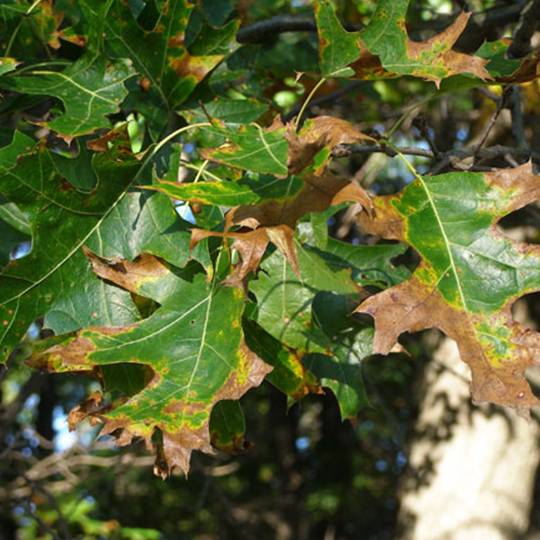
Oak trees, belonging to the genus Quercus, which includes over 600 different species of trees, have stood tall in America’s landscapes for centuries and can live over 200 years. These hardwoods offer us plenty of shade and are also favored for their grand appearance and the beautiful backdrop of color they provide during the fall months.
Oak wilt is a fatal and fast-spreading disease that affects these trees and is caused by the fungus Ceratocystis facacearum. This disease affects the vascular system of the tree, preventing the proper flow of water and nutrients, and eventually killing it. Although all oaks are susceptible to oak wilt, the red oak is more susceptible to the disease than the white oak species. White oaks tend to develop symptoms more slowly and often recover, while red oaks usually die soon after infection.
How Oak Wilt Spreads
The oak fungus is spread in one of two ways: Fungal spores are either transported to healthy trees by insects, or the fungus travels from a diseased tree to a healthy one via root grafts.
Although scientists have not identified all of the insects that may transport the fungus responsible for oak wilt, sapfeeding beetles are definitely big carriers. The beetles themselves do not transport the fungus very far, but it (and the insects) can be carried over longer distances within transported firewood.
Similar to Dutch elm disease, the fungus can also spread from one tree to neighboring trees through interconnected root systems, or root grafts. Therefore, once the disease affects one oak tree, others nearby are soon to follow.
Oak Wilt Signs and Symptoms
Often occurring in later spring or summer, symptoms can vary in different oak species. But signs that a red oak is infested usually include the following:
- Discoloration of leaves
- Wilted or curled leaves
- Complete leaf drop that occurs by mid summer
- Dead crowns (upper portions of the trees)
- Suckering at the base of the tree
- Eventual death
White oaks may display these symptoms, but they are usually slower to spread and remain more localized on individual branches.
Managing the Disease
Prevention is key with oak wilt, as there is no cure for the disease. There are preventative treatments, but trees that are already infected with oak wilt should immediately be removed and destroyed before the disease spreads to healthy trees. Breaking of the root grafts should take place before the infected tree is removed and can be accomplished with professional machinery.
Because fresh cuts or wounds can attract fungus-carrying insects, red oaks should only be pruned during the winter months when the beetles are less active.
Fungicide injections can be applied by a professional. This preventive treatment is inserted into the tree’s trunk and often must be repeated seasonally.
Another way to prevent oak wilt from spreading is to stop the transportation of infested logs and firewood. Logs from red oaks should not be transported unless all bark is removed, while white oak logs can be used safely as firewood.
To learn more about identifying and controlling oak wilt or other tree diseases, contact Elite Tree Care at 610-935-2279.
Need Help with Oak Wilt Disease?
Call Elite Tree Care today at 610-935-2279 and let's talk about how we can help you with Oak Wilt Disease and other Pennsylvania tree diseases.
Get a Free Quote